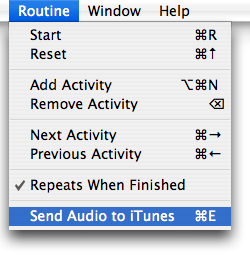January 16th, 2007
FlexTime 1.2 is out today, with the highly anticipated “Send Audio to iTunes” feature!

Why would you want to send audio to iTunes? It’s the fastest route to the iPod. Many FlexTime routines beg to be taken away from the computer. By sending audio to iTunes, users can easily collect a number of routines on their iPod and play them at their convenience.

Me, personally? I’ll probably use this feature to take my yoga routine with me on trips. Back when I was in music school I would have loved this feature for practicing complex polyrhythms. Basically you’d spot me walking down the street in a sort of hypnotic daze as I conducted one rhythm with my arm and spoke a different one (“ta, ta, ta-ta”). FlexTime would have been a great practice aid for that!
Posted in FlexTime | 3 Comments »
January 16th, 2007
While I’m busy turning this into a links blog, I should point to Paul Kafasis’s excellent writeup about exhibiting at MacWorld.
Paul takes an “is it worth it” analytical approach that should be interesting to most of us and really useful to anybody considering exhibiting.
File under: future fantasy reference.
Posted in Business, Links, Technology | 4 Comments »
January 16th, 2007
Wil Shipley writes about advertising Delicious Library. Ostensibly, the article is about advertising in general, though it quickly turns into a long exploration of Google Ads.
Still, interesting stuff for anybody who is thinking about advertising, and some of Wil’s best writing yet.
Posted in Business, Technology | Comments Off on Wil Shipley On Advertising
January 16th, 2007
Mike Zornek’s Billable application makes it easy to track time and invoice clients from your Mac. Version 1.1 adds features to facilitate custom invoice numbers, per-client memos, and the ability to tax billed services (especially useful for European customers).
Posted in Software Reviews | 1 Comment »



